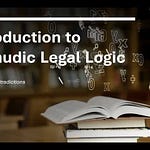Hi Everyone - earlier in the week we walked through a dispute between two approaches to biblical text: Rabbi Yishmael’s narrow reading, involving generalization and detail (כלל ופרט) and Rabbi Akiva’s broad reading, involving amplification and restriction (ריבוי ומיעוט). As promised, here’s a video that explains the difference - we are likely to encounter this controversy several times in the future.
The problem these approaches address has to do with the opaqueness of the biblical text. If you were to write a statute today, you’d want to be crystal clear about whether a list in a statutory provision was open or closed, and you’d probably use terms like “except for…” or “for example, but not limited to…” to eliminate the need for exegetical gymnastics. Since the sages did not have the benefit of statutory clarity, they chose the tests they used based on their approach to the text: should it be read, as Rabbi Yishmael preferred, close to what it seems to say in everyday language (דיברה התורה בלשון בני אדם) or, as Rabbi Akiva preferred, in a way that finds layers of meaning in every letter?











